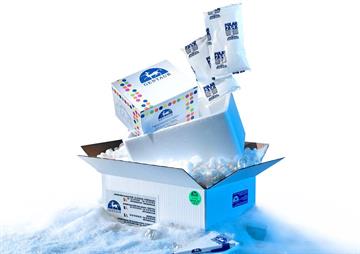Anti-Human Wnt-3a Antibody

Anti-Human Wnt-3a Antibody
457.12 EUR
In Stock
quantity
Produktdetaljer
Katalognummer: 209 - 102-PA140
Produktkategori: Företag och industri > Vetenskap och laboratorium
ReliaTechGentaur
Storlek: 200 µg
Related Products
102-P257
Anti-Human Wnt-3a Antibody
Wnt-3a is one of about 19 vertebrate members of the Wingless-type MMTV integration site (Wnt) family of highly conserved, cysteine-rich secreted glycoproteins important for normal developmental processes. Wnts bind to receptors of the Frizzled family in conjunction with a coreceptor of the low-density lipoprotein receptor-related protein family (LRP-5 or -6), or the Ryk atypical receptor tyrosine kinase. During development, Wnt-3a is a morphogen that is thought to coordinate somitogenesis and mesoderm boundary determination. When Wnt-3a is deleted, mice fail to develop a hippocampus, and show defects in anterior-posterior patterning, somite development and tailbud formation. Wnt-3a has also been implicated in chondrocyte differentiation. Like other Wnts, Wnt-3a is modified by palmitate addition (at Cys 77) following glycosylation, which increases its hydrophobicity, secretion and activity. A second site at Ser 209 modified by palmitoleic acid also contributes. Human Wnt-3a shares 96% amino acid (aa) identity with mouse, bovine and canine Wnt-3a, and 89%, 86% and 84% aa identity with chicken, Xenopus and zebrafish Wnt-3a, respectively. It also shares 87% aa identity with Wnt-3. Human Wnt-3a is a 44 kDa secreted hydrophobic glycoprotein containing a conserved pattern of 24 cysteine residues.
518.55 €
102-PA140
Anti-Human Wnt-3a Antibody
Wnt-3a is one of about 19 vertebrate members of the Wingless-type MMTV integration site (Wnt) family of highly conserved, cysteine-rich secreted glycoproteins important for normal developmental processes. Wnts bind to receptors of the Frizzled family in conjunction with a coreceptor of the low-density lipoprotein receptor-related protein family (LRP-5 or -6), or the Ryk atypical receptor tyrosine kinase. During development, Wnt-3a is a morphogen that is thought to coordinate somitogenesis and mesoderm boundary determination. When Wnt-3a is deleted, mice fail to develop a hippocampus, and show defects in anterior-posterior patterning, somite development and tailbud formation. Wnt-3a has also been implicated in chondrocyte differentiation. Like other Wnts, Wnt-3a is modified by palmitate addition (at Cys 77) following glycosylation, which increases its hydrophobicity, secretion and activity. A second site at Ser 209 modified by palmitoleic acid also contributes. Human Wnt-3a shares 96% amino acid (aa) identity with mouse, bovine and canine Wnt-3a, and 89%, 86% and 84% aa identity with chicken, Xenopus and zebrafish Wnt-3a, respectively. It also shares 87% aa identity with Wnt-3. Human Wnt-3a is a 44 kDa secreted hydrophobic glycoprotein containing a conserved pattern of 24 cysteine residues.
457.12 €
102-PA140S
Anti-Human Wnt-3a Antibody
Wnt-3a is one of about 19 vertebrate members of the Wingless-type MMTV integration site (Wnt) family of highly conserved, cysteine-rich secreted glycoproteins important for normal developmental processes. Wnts bind to receptors of the Frizzled family in conjunction with a coreceptor of the low-density lipoprotein receptor-related protein family (LRP-5 or -6), or the Ryk atypical receptor tyrosine kinase. During development, Wnt-3a is a morphogen that is thought to coordinate somitogenesis and mesoderm boundary determination. When Wnt-3a is deleted, mice fail to develop a hippocampus, and show defects in anterior-posterior patterning, somite development and tailbud formation. Wnt-3a has also been implicated in chondrocyte differentiation. Like other Wnts, Wnt-3a is modified by palmitate addition (at Cys 77) following glycosylation, which increases its hydrophobicity, secretion and activity. A second site at Ser 209 modified by palmitoleic acid also contributes. Human Wnt-3a shares 96% amino acid (aa) identity with mouse, bovine and canine Wnt-3a, and 89%, 86% and 84% aa identity with chicken, Xenopus and zebrafish Wnt-3a, respectively. It also shares 87% aa identity with Wnt-3. Human Wnt-3a is a 44 kDa secreted hydrophobic glycoprotein containing a conserved pattern of 24 cysteine residues.
339 €
SPC-783D-PCP
Rabbit Anti-Human WNT3 Polyclonal
A polyclonal antibody for WNT3 from Human | Mouse. The antibody is produced in rabbit after immunization with human synthetic peptide from the C-terminal of Human Proto-oncogene Wnt-3 (aa. 280-330). The Antibody is tested and validated for WB, IHC assays with the following recommended dilutions: WB (1:1000); IHC (1:50). This WNT3 antibody is conjugated to PerCP.
691.1 €
SPC-783D-RPE
Rabbit Anti-Human WNT3 Polyclonal
A polyclonal antibody for WNT3 from Human | Mouse. The antibody is produced in rabbit after immunization with human synthetic peptide from the C-terminal of Human Proto-oncogene Wnt-3 (aa. 280-330). The Antibody is tested and validated for WB, IHC assays with the following recommended dilutions: WB (1:1000); IHC (1:50). This WNT3 antibody is conjugated to RPE .
689 €
SPC-783S
Rabbit Anti-Human WNT3 Polyclonal
A polyclonal antibody for WNT3 from Human | Mouse. The antibody is produced in rabbit after immunization with human synthetic peptide from the C-terminal of Human Proto-oncogene Wnt-3 (aa. 280-330). The Antibody is tested and validated for WB, IHC assays with the following recommended dilutions: WB (1:1000); IHC (1:50). This WNT3 antibody is unconjugated.
336.2 €
Håll dig uppdaterad! Visa tidigare publikationer

By: Author , 2 Comment
Anaplasmos hos hundar och katter – allt du behöver veta
23 August 2025

By: Author , 2 Comment
Solbränna – hur leker man säkert i solen?
16 August 2025

By: Author , 2 Comment
Biologiska läkemedel – Modernitet inom farmaci
1 August 2025

By: Author , 2 Comment
Icke-steroida antiinflammatoriska läkemedel – viktig information om populära läkemedel
22 July 2025








